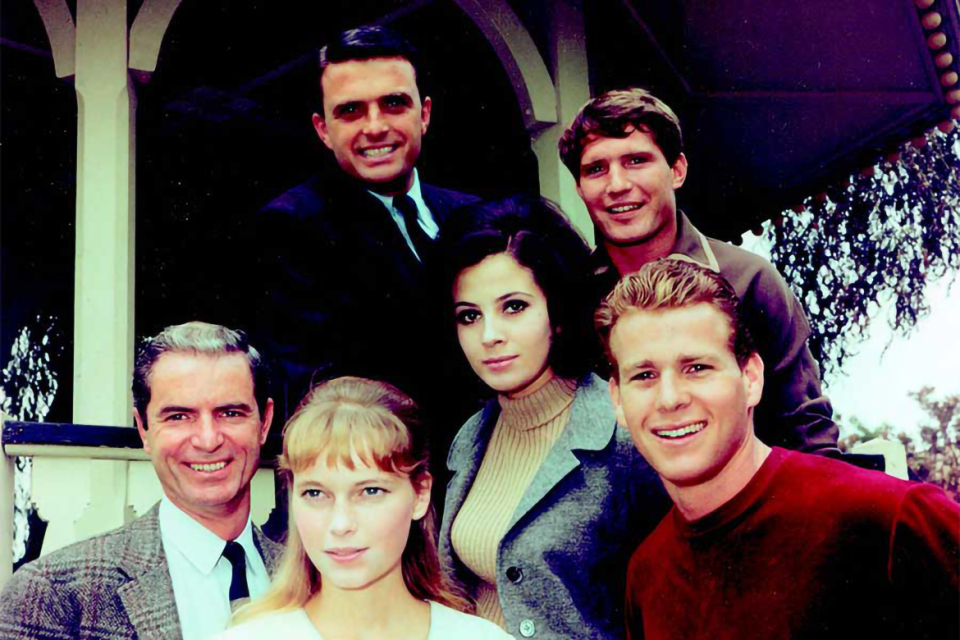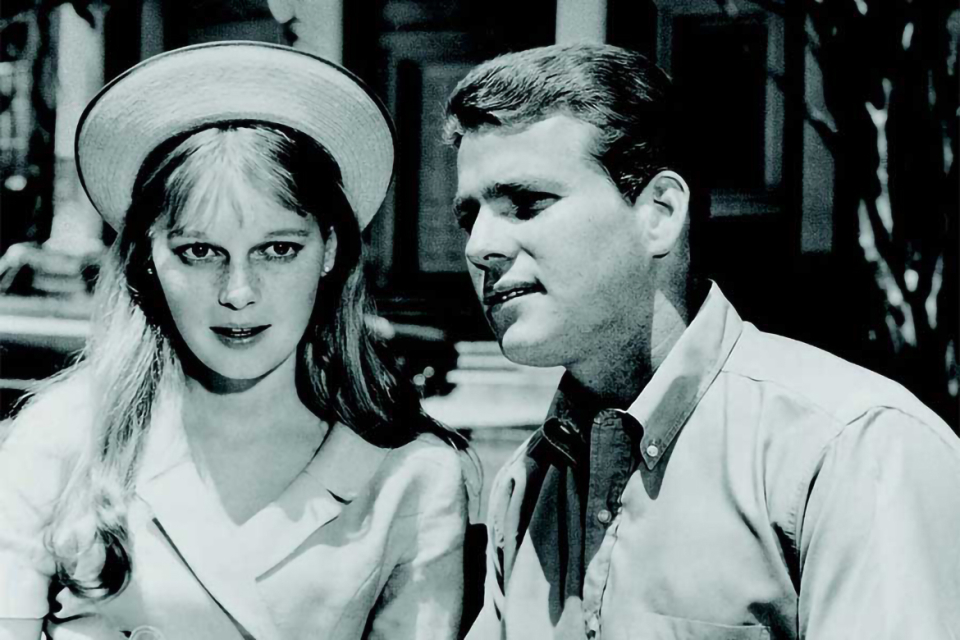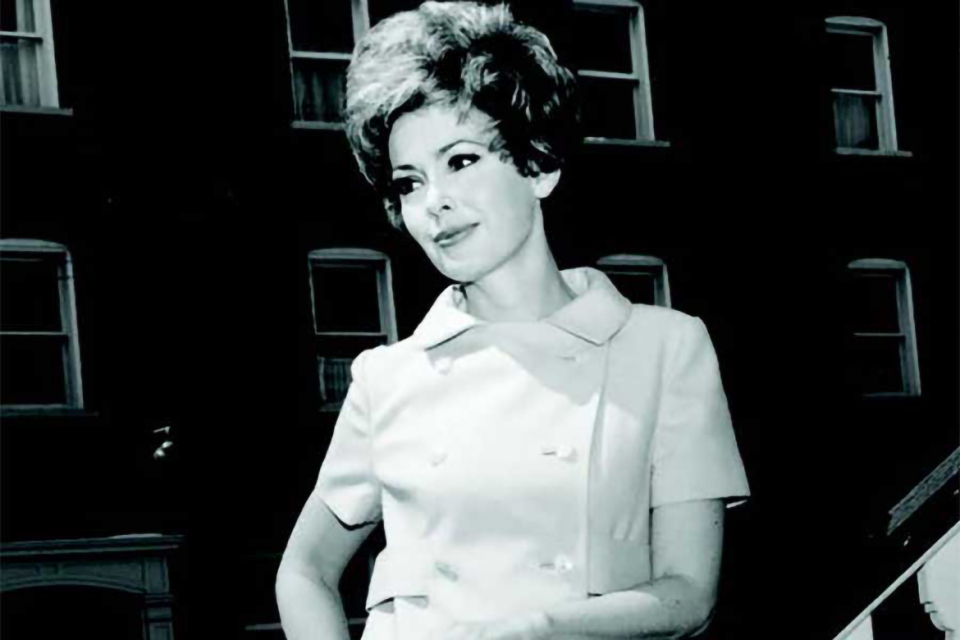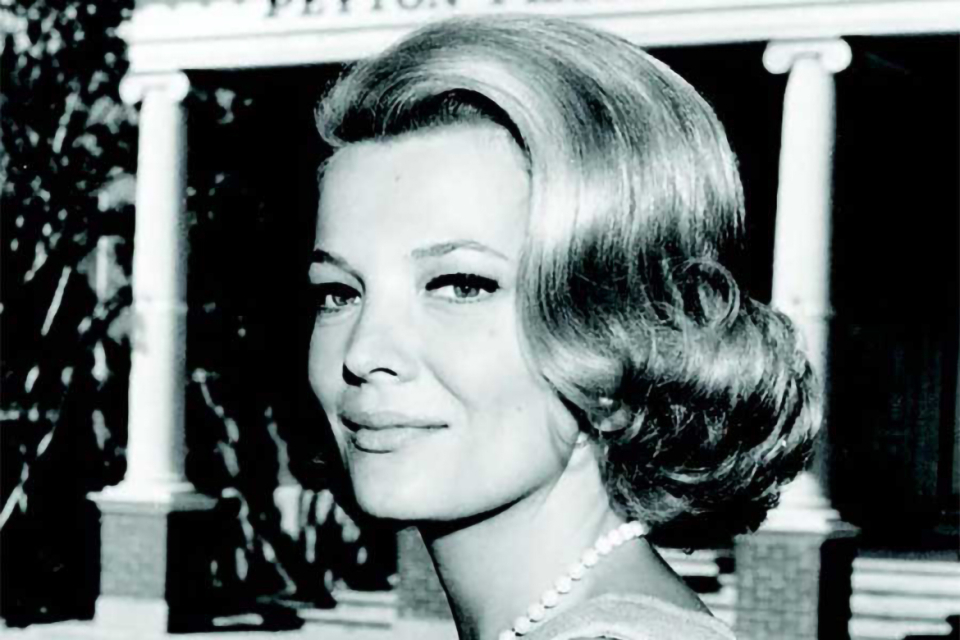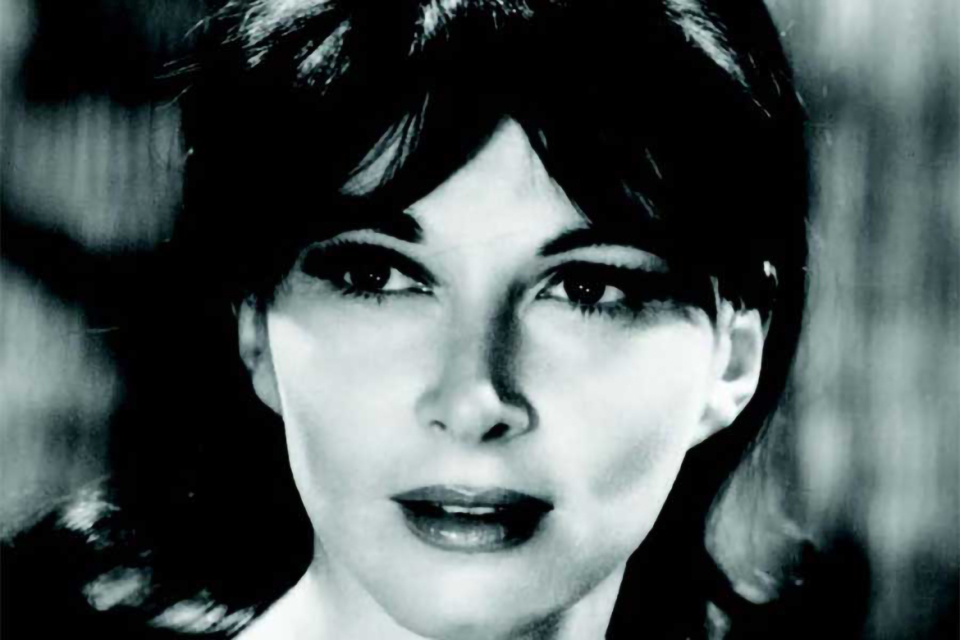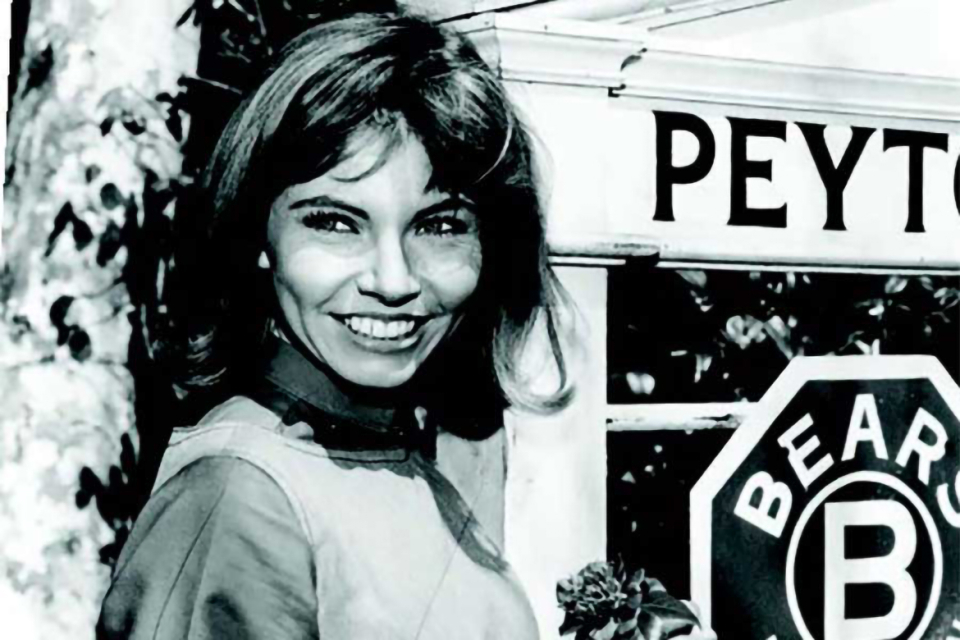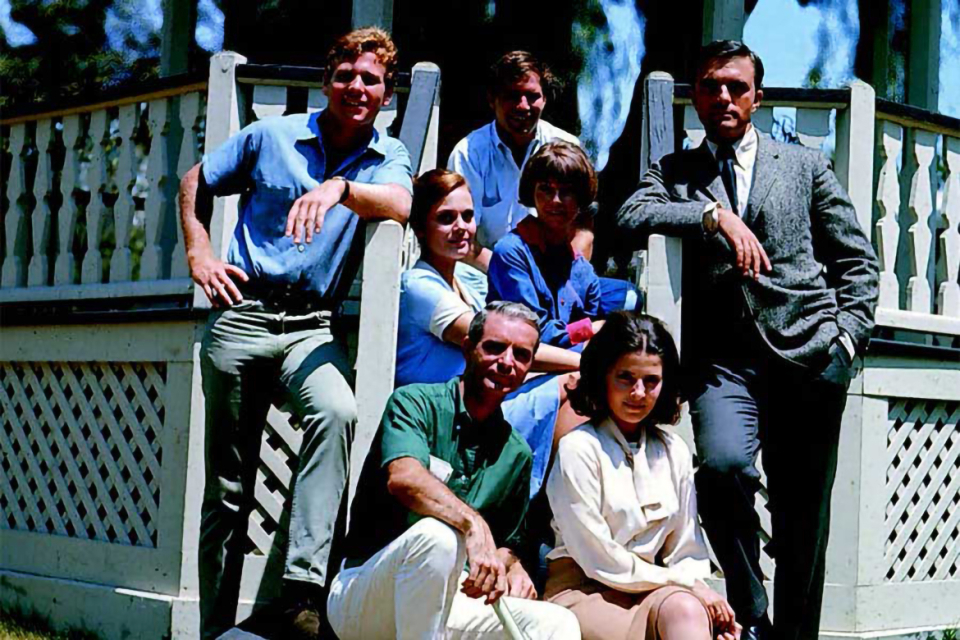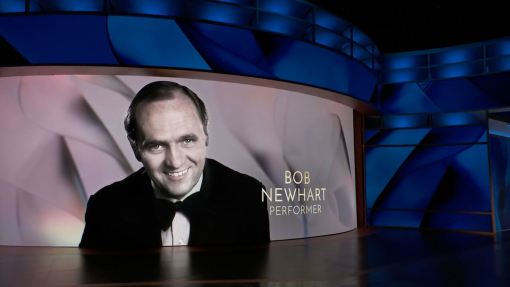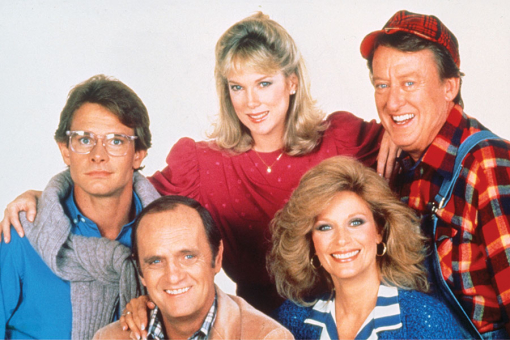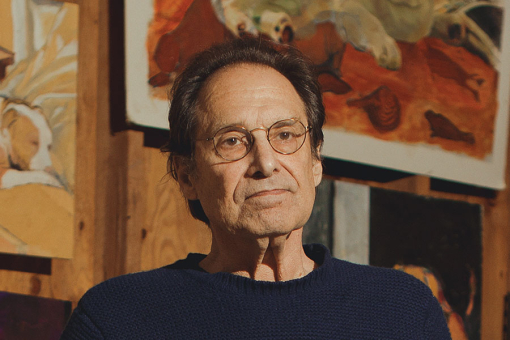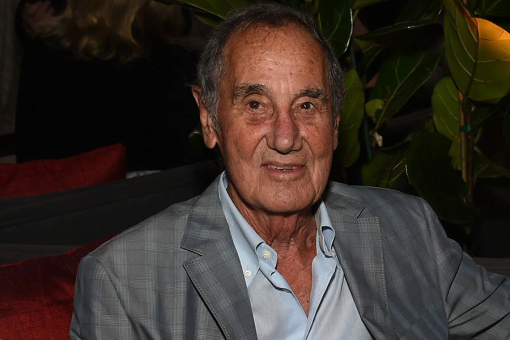In the happy-go-lucky television landscape of 1964 — packed with such wholesome fare as Gilligan's Island, The Adventures of Ozzie & Harriet and The Lawrence Welk Show— the drama Peyton Place stood out.
How could it not? Its plotlines were rife with adultery, alcoholism, wife beating, mental breakdowns and murder.
Based on Grace Metalious's 1956 best-selling novel about sex and hypocrisy in a small New Hampshire town, the series — which debuted on ABC on September 15,1964 — was TV's first primetime soap opera. While the novel's most salacious storylines were toned down for TV, the series was the first in primetime to candidly portray sexuality and issues such as domestic violence and mental illness.
Many of the conflicts played out between the haves, who lived on the good side of Peyton Place, and the have-nots on the other side of the tracks.
Appearing as high school students at the start, Mia Farrow and Ryan O'Neal — as shy Allison Mackenzie and charming Rodney Harrington — were catapulted to stardom. Dorothy Malone costarred as Allison's mother Constance; Ed Nelson played Dr. Michael Rossi; and Barbara Parkins was Rodney's devious girlfriend, Betty Anderson.
Over the show's five-season run (1964-69), the cast also included Dan Duryea, Lee Grant — who won an Emmy in 1966 for her performance — John Kerr, Susan Oliver, Leslie Nielsen, Percy Rodriguez and Gena Rowlands. Early on, the series aired twice weekly, but it became so popular that the network added a third night.
But well before Peyton Place was the talk of television, it was a movie: in 1957 20th Century Fox released its film adaptation of the novel, with Lana Turner heading a large cast.
The studio subsequently launched the TV show, executive produced by Paul Monash, who had previously written for such TV dramas as Playhouse 90 and The Asphalt Jungle. Irna Phillips, who had a long career in daytime drama and was known as the Queen of the Soaps, was brought in as a creative consultant.
Yet, throughout the show's run, it was Monash who insisted that the show was not a soap opera — he called it "a high-class anthology drama."
More than 500 episodes were filmed at Fox studios in Hollywood, with Ted Post and Walter Doniger the key directors; two units were almost always working at once. The series was shot in black-and-white for the first two seasons, then went to color in 1966.
Scripts, not surprisingly, focused chiefly on sexual encounters and love affairs, and off the set some of the young actors became romantically involved.
O'Neal and Leigh Taylor-Young (who played Rachel Welles) married during the run of the show; Stephen Oliver and Lana Wood (spouses Lee and Sandy Webber) were also wed briefly. Patricia Morrow and Christopher Connelly (Rita Jacks and Norman Harrington) dated for two years.
Thanks to Farrow, two backstage events generated huge headlines for the show. The first was when the actress surprisingly chopped off her long tresses, opting for a super-short pixie do. The second was when she quit the series at the end of its second season, precipitating a ratings drop and reversion to two episodes a week.
But the show was sufficiently popular to remain on the air for another three seasons. Even after it was canceled, a daytime series, Return to Peyton Place, ran for two seasons (1972-74), followed by two telefilms (1977 and 1985).
To mark the show's 50th anniversary, emmy contributor Jane Wollman Rusoff interviewed eleven alumni and found that their memories of Peyton Place, even a half century later, remain remarkably vivid.
Those alumni included Ed Nelson, who died August 9, 2014 at age 85. His conversation with Jane Wollman Rusoff was one of his last interviews.
Dramatic License
Ryan O'Neal (Rodney Harrington, 1964-69): Cleopatra [the 1963 Elizabeth Taylor film] cleaned out the Fox studio. They said: "We need to make some money or we're going under."
So they looked through a pile of movies they owned and one of them was Peyton Place. It wasn't a soap opera — it was a "visual novel." That's what we were told to say.
Mia Farrow (Allison Mackenzie, 1964-66): For me, the show was like school: you went there in the morning, you worked all day and you came home at night.
After the pilot, my mother [Maureen O'Sullivan] told me how bad she thought the plot was. She said I should get out of the show.
Gena Rowlands (Adrienne Van Leyden, 1967-68): We all had fun. That show was so preposterous! There was a lot of bad stuff going on all the time. Somebody was always double-crossing somebody. It was very crazy. You didn't take it seriously.
Ed Nelson (Dr. Michael Rossi, 1964- 69): When we were on three times a week in primetime, we got letters from husbands complaining, "Hey, that's our primetime, too!"
Lee Grant (Stella Chernak, 1965-66): It was an easy place to go. You didn't have that feeling of, "I've got to get this right or I'll be fired." It had an up-swinging, young people's feel.
Peyton Place was a turning point for me. I was just off the blacklist, but my name wasn't listed in the credits of my first episode.
I had spent a good 10 years fighting against the blacklist and for people's names to be on the screen. I told Paul Monash that if my name wasn't on it, I couldn't do the show. He agreed right away."
Role Play
Nelson: [As Dr. Rossi] I had a lot of medical stuff to do. But all my patients died! I went to Paul and told him, "I'd like to save somebody." He looked at me: "Save 'em? Boring! Boring! Boring!"
Farrow: I loved my character. She was very close to a certain part of me, barely out of childhood — I was right out of high school.
I was very shy and so was she. She had a crush on Ryan O'Neal's character, and I had a crush on Ryan O'Neal.
Barbara Rush (Marsha Russell, 1968-69): The show [polarized] good people and bad. My character was one of the good people — I never got to do anything naughty.
Marsha was a divorcee who moves to Peyton Place and meets Dr. Rossi. Her ex-husband was stalking her and showing up at two in the morning. She was frightened. Dr. Rossi kept rescuing her.
Rowlands: [Producer] Everett Chambers called and asked, "How would you like to play an old Joan Crawford role — a bad lady?"
My duty was to go in there and break up anything that was good and get old man Peyton's money. Nobody liked me. My character was bad, and everybody knew it but Mr. Peyton.
Kimberly Beck (Kim Schuster, 1965-69): I was seven when I did the show. The lucky thing was, because my character was [initially] deaf and mute, I didn't have to learn lines.
But after Kim witnessed a violent death, she started to speak — and it was very hard. When we were looping, I had to learn the speech pattern of somebody who had never heard anything and sound like I was deaf.
So I held my tongue with my hand, and they put rocks in my mouth.
Grant: Stella was a bad girl from the other side of the tracks. She was quirky and dangerous. She had a romance with Dr. Rossi. What more could a girl ask for?
Action!
Patricia Morrow (Rita Jacks Harrington, 1965-69): When my character and Norman [Christopher Connelly] eloped, we went to a motel. The room had two single beds.
I was instructed by the Standard & Practices woman that, as Norman started to kiss me while I was sitting on the side of the bed, if one of my feet left the ground, she would stop the shooting.
Rush: Ed [Nelson] and I had an awful lot of love scenes. He would tease me about them afterward: "Oh, you went too far!"
Rowlands: Wilfrid Hyde-White was playing old man Peyton when I was doing the show. He was quite a bit older than the rest of us.
I said to him: "How do you remember all that dialogue?" He turned over a cigarette box that was in the scene — on the bottom he had all his lines written out.
All in the Family
Lana Wood (Sandy Webber, 1966-68): We were a tad dysfunctional, but we were a family. Paul was the brick that kept all things pulled together.
Ryan and I had a brief [personal] relationship, but on the set I found him to be judgmental and stayed away from him. He'd say, "Do something about your hair." He didn't like that it would curl.
Morrow: Ed Nelson was the resident comedian. He made us all laugh, while still being the consummate professional. He really was one of the good guys.
Grant: Mia was otherworldly. She was very diffident with people and didn't talk in the makeup room. She was involved with her deaf white cat and going with Frank Sinatra.
Ryan was a delicious, flirty boy with everybody, the most charming and the sweetest.
Everett Chambers (producer, 1965-69): [Director] Walter Doniger was a control freak and very restricting. He was famous for doing long scenes with sometimes 12 or 15 camera moves.
The actors had to hit those marks. Some of them didn't want to be that controlled, so he'd run into conflicts with them. He shot good shows, but when his contract came up, I'd had it and told Paul that I'd prefer not working with him anymore.
He said okay, and we let him go."
Beck: Mia was the most inspirational person, maybe ever, in my life. She told me I was magic and special and a beautiful person.
When she was dating Frank Sinatra, she took me for weekends to stay at his house in Bel-Air. She was very motherly toward me.
Nelson: Paul Monash was one of those guys who, if you asked him a question, would give you an answer instead of saying, "I'll get back to you on that."
Farrow: Ryan was the funniest person I had ever met. He made me laugh disgracefully.
At the end of the day, when they were trying to get a shot and I was tired, I couldn't stop laughing. A couple of times I was sent home because I couldn't get through the scene. Ryan would say, 'Dead baby, dead baby,' to try to sober me up.
And that, of course, put me over the top. I had to go home and send people flowers the next day.
Dorothy Malone was going through a marital breakup, I think, and had small children. So she wasn't like we were —laughing and playing around. She came, did the work, did it well and went home.
Before Lee Grant arrived, the buzz was that this great New York actress was coming — rev up your game.
O'Neal: "Working with Mia was a trip. I was just fascinated by her. Her acting was always impeccable. We spent a lot of time together on the lot, and I was terribly sad when she left.
She was replaced by a lovely girl, Leigh Taylor-Young, who I took a liking to — in fact, more than a liking. I married her.
Dorothy Malone was a really good dish, very sweet but a little spacey. She was always late and sort of learning her lines when she got there. She'd park the car, lock the door and run to the soundstage, leaving the engine running and her keys in the car. We'd have to open the hood and undo the batteries.
Leigh Taylor-Young (Rachel Welles, 1966-67): Ours was a very eccentric, artistic family. I did a lot of my initial scenes with Ed Nelson, who was more mature and older and so wonderful to me.
Then I graduated to more scenes with Ryan. He was the center of attention and had a tremendous love of being funny.
Just for Fun
Wood: I was one of the heavyweight kidders and pranksters. Once, I got a blood capsule from the makeup room and stood outside the stage door waiting for someone to come through. When they did, I bit on the capsule and pretended they hit me in the face with the door.
Another time, I brought in a cap gun and, while having lunch with Mia in the commissary, pulled it out of my purse. I didn't realize there was a cap left until I pulled the trigger and it went off.
The next thing I know, Walter Matthau is tapping me on the shoulder: "Young lady, I have a heart condition!"
It was known that Ruth Warrick had problems getting her lines in order. When her character [Hannah Cord] was on the stand in a long courtroom scene, we all drew numbers betting how many takes she'd have to do.
She found out and gave us a proper chewing out for being unprofessional and a bunch of rowdy kids, which we were.
Taylor-Young: Ryan and I had one scene where I was supposed to faint, and he would pick me up and carry me down the courtroom steps to his car. That's the way we rehearsed it.
But on [the shoot day], I put a deep-sea diving weight around my waist under my sweater, which added about 60 pounds. He couldn't lift me up. He tried and tried.
Finally, he threw his hands in the air: "Okay, I can't do this!" Everybody on the set broke up when I lifted my sweater.
Morrow: Right after Mia cut her hair, the mood was very tense. Everybody was absolutely furious at her.
She was doing a scene in a hospital bed, with all the ABC executives and ad agency people watching. Ed Nelson entered — completely bald. He had the makeup guy put a skinhead on him.
Mia probably didn't laugh, but [the cast and crew] cracked up. I think the network and agency folks were smirking.
Strictly Confidential
Taylor-Young: Ryan and I tried to keep [our relationship] a secret, but one day Paul and Everett called me in, like two fathers wanting to chat with their daughter. They said, "We don't like you riding on his motorcycle. We want you to be careful."
Farrow: I was offered two hairdos: a flip and a bubble. But I made the argument to the brass that my character would have her hair almost waist-length, the way I was wearing it.
Actually, I wanted it that way so I wouldn't have to go to hairdressing and could ride my horse early in the morning.
Though it's been attributed to hairstylists, I cut my hair myself in the dressing room. This sounds radical, but because I was a deeply religious person in my convent boarding-school days and beyond, I felt that one of the worst sins was vanity. I was receiving a pillowcase full of mail a week with compliments about my hair, and I was worried that it would make me feel vain or proud.
So, I thought: the hair has got to go. I'll get rid of it — and then I could still ride my horse in the morning.
Also, by then I had a boyfriend [Frank Sinatra], and sometimes I wanted to sleep later and not be messing with my hair. I was waiting for a time when cutting my hair could be put seamlessly into the show.
When they put my character in an insane asylum, I thought it would be very easy in that situation for her to chop off her hair. So I cut it and put it in a bag.
Well, you would have thought I'd burned down the building! They were rushing at me with wigs.
I still don't know what all the fuss was about. Paul wrote me a letter about my responsibility to the cast and crew and to their mortgages. I didn't see it as a problem for anybody. And I was right — it wasn't a problem for the show or for anyone's mortgage.
I kept my hair short. My boyfriend loved it.
Grant: Oh, my God, when Mia cut her hair, it turned out to be such a big public event.
She was like a little fawn in the makeup room, up against the back wall, protecting herself from the onslaught of hairdressers. It became a huge thing for the show.
Chambers: We were a lily-white series, and it was finally decided to get updated and put in a black family.
Word got out that Tippy Walker's character [Carolyn Russell] was going to have a relationship with a black man. Well, we got mail that was really, really angry. One woman said if we did that, she'd nail us up against the garage door.
I talked Paul into getting a black psychologist to come in and orient the white writers before we hired a black writer.
Ruby Dee played Alma Miles. She and her [real- life] husband [Ossie Davis] came to those meetings to help make sure that we weren't in a white [people's] fantasy.
It's a Wrap
Farrow: I left because my husband [Sinatra] didn't want me to continue with it. He wanted to travel and he wanted me with him.
He was working for Fox, so he was able to make that happen. But he also thought the show was running out of steam and that I shouldn't be doing it.
Rowlands: I only wanted to do a limited number of episodes. I knew it was time for me to go when they pushed [my character] down the stairs and she died.
Taylor-Young: I left the show on an act of God clause because I was pregnant. Ryan and I got married, and a week after my son [Patrick O'Neal] was born, they dropped my contract.
The next week, I was hired for [the feature] I Love You, Alice B. Toklas!
O'Neal: At the end of five years they asked me to sign on for another three.
I said, "I just can't. I can't figure out what to do with my character anymore. I'm saying the same lines I said three years ago, just with different women."
So I left and tested for Love Story. As it turned out, the character was the same guy I played on Peyton Place.
This article originally appeared in emmy magazine issue #8, 2014

